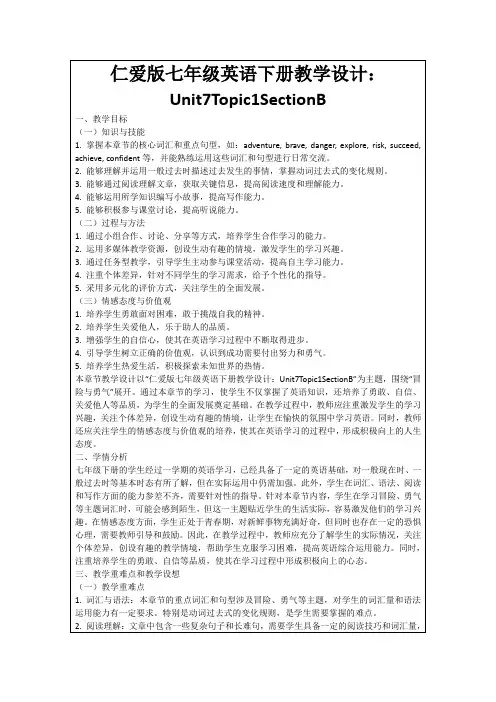七年级下册英语教学设计
人教版新目标七年级英语下册 Unit 2教学设计

人教版新目标七年级英语下册 Unit 2教学设计一. 教材分析人教版新目标七年级英语下册Unit 2主要围绕日常生活话题,让学生学会描述日常活动、表达喜好和计划。
本单元包括三个部分:听说课、读课和综合语言运用课。
听说课主要训练学生的听说能力,读课通过阅读提高学生的理解能力,综合语言运用课则培养学生的综合语言运用能力。
二. 学情分析七年级的学生已经掌握了基本的英语语音、词汇和语法知识,具备一定的听说读写能力。
但部分学生对英语学习仍存在恐惧心理,缺乏自信心。
因此,在教学过程中,教师需要关注学生的情感态度,激发他们的学习兴趣,提高课堂参与度。
三. 教学目标1.知识目标:学生能够掌握日常生活中常用的词汇和表达方式,如goto school, read books, watch TV等。
2.能力目标:学生能够在真实情境中运用所学知识进行日常交流,提高听、说、读、写的能力。
3.情感目标:学生能够积极参与课堂活动,提高学习英语的自信心和兴趣。
四. 教学重难点1.重点:学生能够熟练运用日常词汇和句型描述日常生活。
2.难点:学生能够正确使用一般现在时表达习惯性动作和喜欢的事物。
五. 教学方法1.任务型教学法:通过完成各种实际任务,让学生在实践中学习、运用英语。
2.情境教学法:创设真实的语境,激发学生的学习兴趣和积极性。
3.情感教学法:关注学生的情感需求,营造轻松、愉快的学习氛围。
六. 教学准备1.教师准备:提前备课,熟悉教材内容和教学目标。
2.学生准备:预习新课内容,复习相关知识点。
3.教学资源:准备多媒体教学课件、图片、实物等。
七. 教学过程1.导入(5分钟)利用图片或实物展示日常生活中的人物和活动,引导学生谈论他们的日常喜好。
例如,展示一张学校操场上的图片,让学生描述图片中学生在做什么。
2.呈现(10分钟)教师通过PPT展示本节课的主要词汇和句型,如go to school, read books, watch TV等,并用例句展示如何运用这些词汇和句型。
七年级英语下册教学计划

七年级英语下册教学计划七年级英语下册教学计划(通用10篇)时间流逝得如此之快,我们又将接触新的知识,学习新的技能,积累新的经验,立即行动起来写一份计划吧。
相信许多人会觉得计划很难写?下面是店铺为大家收集的七年级英语下册教学计划,仅供参考,大家一起来看看吧。
七年级英语下册教学计划篇1一个寒假转眼间就过去了,新的学期又将开始,为了下学期更好地搞好七级英语教学工作,特做以下教学计划:一、指导思想依据学生上学期掌握知识情况和学生的生理和心理以及发展需求,本学期我们的英语课程的教学目的是如何培养学生的口语表达能力、听力水平和语言表达能力。
教师要激发学生学习英语的兴趣,培养他们学习英语的积极态度,使他们建立学习英语的自信心;培养学生的语感和良好的语音、语调基础,使他们形成初步运用英语进行日常交流的能力,为进一步学习打下基础。
同时用新课标理念,结合新课标精神,进行课堂改革,实行教与学的互动。
采用任务型语言教学模式,努力用一套行之有效的课堂教学模式,提高教学效率。
二、基本情况经过一学期的学习体会,我所教的两个班,大部分学生学习目的明确,学习态度端正,掌握了英语学习的一些基本方法,能够积极主动认真地学习,学习成绩较好。
但还有少部分学生没有明确的学习目的,缺少学习的热情和主动性,自觉性和自控力都较差,相应的学习习惯也差。
主要原因是没有激发学生学习英语的兴趣,学生觉得英语学习是一种负担,而不是一种乐趣。
一部分学生没有掌握记忆单词的方法,连基本的单词听写也不过关,导致看不懂,听不懂,学不懂。
学生的听力也还有待提高,在这方面失分也较多。
主要是听的时间太少,接触英语的时间不多。
针对种种问题,在本学期的英语教学中,教师一方面应加强基础知识的讲解和基本技能的训练,让学生掌握词汇、语法、句型等基础知识和听、说、读、写等基本技能,为进一步学习英语打下坚实的基础;另一方面,又要采取多种措施,注意培养学生对英语的兴趣;让学生掌握记忆单词、听力、写作等英语学习技艺,培养良好的学习习惯和自主探索,合作探究能力。
人教版七年级英语下册Unit10(阅读课)教学设计

(一)导入新课(500字)
1.教师通过向学生展示一组体育活动的图片,如篮球、足球、乒乓球等,引导学生回顾已学的相关词汇,为新课的学习做好铺垫。
2.邀请学生分享他们最喜欢的体育项目,并简单介绍这个项目的特点,激发学生对本单元话题的兴趣。
3.教师提出问题:“Do you know any famous sports players?”,让学生尝试用英语谈论自己了解的体育明星,为后续学习做好语言准备。
4.创设情境,播放一段关于体育比赛的短视频,引导学生关注视频中的关键信息,为新课的阅读理解打下基础。
(二)讲授新知(500字)
1.教师带领学生阅读课文,让学生初步了解文章的主旨和大意,引导学生关注文章中出现的生词和短语。
2.对文章中的重点词汇和短语进行讲解,如:baseball, player, team, win, lose, score, goal, match, competition等,并通过例句展示这些词汇的用法。
1.培养学生对英语学习的兴趣,激发他们学习英语的热情。
2.培养学生积极参与体育活动,锻炼身体,增强体质的意识。
3.培养学生团队协作、竞争意识,让他们在合作与竞争中不断成长。
4.培养学生尊重他人、关爱他人的品质,学会在人际交往中和谐相处。
5.培养学生的国际视野,了解世界各地的体育文化,拓宽知识面。
二、学情分析
2.任务型教学法:设计各种任务,引导学生积极参与,培养他们合作、探究的学习精神。
3.交际法:鼓励学生进行课堂互动,提高他们的英语口语表达能力。
4.自主学习法:培养学生独立思考、自主学习的能力,让他们在课后主动复习和拓展知识。
5.比较法:通过比较不同国家的体育文化,让学生了解世界文化的多样性。
人教版初中英语七年级下册全册英教案(全英文版)

新目标人教版英语七下全册教案(全英文版)Unit 1 Wheres your pen pal from?Language goals:•In this unit students learn to talk about countries, nationalities and Ian guages.•Ask and tell where people live.New languages:•Where's he / she from?•He / She is from Australia / England / China / France / Singapore / Australia. •Where does he / she live? He / She lives in Sydney.•What language do you speak? I speak English.•What's your / his / her favorite subject?•My / His / Her favorite subject is English.•Does he / she have any brothers and sisters? Yes, he/ she does. / No, he / she doesn't.Difficult points:1. Liste ning for the in formation about cou ntries, natio nalities and Ian guages. Write an e-mail about on eself. Describe the new stude nts in class.2. Where questions with fromWhere questions with liveWhat questi onsTeaching aids:• A tape recorderTeaching periods:•Period 1:Section A 中1a, 1b, 1c•Period 2:Section A 中2a, 2b, 2c, 2d•Period 3:Section A 中3a, 3b, 4•Period 4:Section B 中1,2a, 2b, 2c•Period 5:Section B 中3a, 3b, 3c, 4•Period 6:Self CheckPeriod 1Teaching aims:1. Teach vocabulary words.2. Target Ianguages:Where's your pen pal from?He is from Australia.3. Enable the students to learn to talk about nationalities.4. Help the students learn how to talk about nationalities.Teaching procedures:Step 1. Free talk2 Say: Do you have any friends? Where is she from?Help the students make the same sentences and give them more chances to say.Step 2. Talking about the picture (1a)Hold up the picture on page 1 and point at the map. Ask students toread the picture.Ask some of you to read them aloud to the class. Make the studentstalk about where people are from.Say: Du Chuan, where is your pen pal from?Ask the students to read the conversations in the picture.Step 3. Listening (1b)Point to the numbered list of words and play the recording for a secondtime.Ask the students to listen to the recording and circle the countries in 1a.Ask students to listen to and repeat after the recording and then checkthe answers.Step 4. Pair work(1c)1. Now work in pairs and read the conversations in 1a with your partner.You can talk about your own pen pal.2. Ask the students to look at their own clothes and the things in theirbackpack. Ask and answer questions about where they are from.Homework1. Ask the students to practice talking about where people are from and make up real dialogues.2. Learn the words in this unit (on page 115) by heart.Period 2Teaching aims:1. Learn the vocabulary words and useful expressions.2. Target languages: Where does he live? He lives in Toronto.3. Let the students learn to talk about where people live.4. Help the students learn how to talk about where people live.Teaching procedures:Step I.StepI RevisionCheck the homework. And then ask several students to answer questi ons.Say: Where are you from? Do you have a pen pal? Where is your pen pal from?Step 2. Presentation (2a)Put a map of the world on the blackboard.Say: What's the meaning of capital? Can you guess? Help them to answer.Write Australia, the United States, Canada, France, and Japan on theleft of the blackboard. And write Sydney, New York, Paris, Toronto, andTokyo on the right of the blackboard. And the teacher reads them aloudand asks students to repeat.Then ask students to match the cities with the countries.Step 3. Talk about countries and citiesAsk the students to work in pairs, asking about the cities and the countries.Say: Now work in pairs and ask where the city is. For example, the firststudent asks "Where is Beijing?” the second student answers “It's inChina."Then tell the students to ask question about Chinese cities.Step 4. Listening (2b, 2c)Tell the students to read the list of countries and cities in 2a.Say: Now let's look at the list of countries and cities in Activity 2a. I will ask some students to read them aloud to the class.Call the students' attention to the chart in 2c.Tell the students to listen to the conversations in Step 4 again to complete the chart.Step 5. Pair work(2d)Ask the students to read the conversations in the bubble. Then askthem to talk about the in formation in the chart in 2c.Then ask the students to work in groups and make up new dialogueswith their own information.Step 6.GrammarfocusReview the grammar box.Say: You have to pay attention the word "from". It always follows verb be, while live comes out alone in where sentences. Now make more sentences with where, from and live.Write the following on the blackboard.Say, now work in pairs and make dialogues after the model above.Homework1. Ask the stude nts to learn the sentence patter ns in Grammar Focus by heart. Try to use them freely.2. Remember the words in this unit (on page 115).3. Make a similar dialogue according to the conversation in 2d.Period 3Teaching aims:1. Teach vocabulary words.2. Target Ianguages: What Ianguage does she speak? She speaks English.3. Enable the students to learn to talk about what Ianguage people speak.4. Help the students to learn how to talk about what language people speak.Step 1. Free talkSay, Morning, boys and girls. Nice to see you again. Do you remember we have learned about how to ask where people are from and how to ask where people live? Now I want some of you to answer my questi ons.(Turn to a student.)Where are you from?Give more students chances to speak in class.Step 2. Presentation (3a)Say: Do you know the meaning of "Ianguage"? Listen: Tim is from England and he speaks English. So English is his Ianguage. I'm fromChina, so Chinese is my language .Now look at activity 3a.on page 3.Read the instructions to the class. Ask students to work in pairs as theyanswer the questions.Show the flowing and ask the students to make conversations after themodel.Step 3. Pair work (3b)Ask the students to pay attention to the conversation in Activity 3b.Say, Read the dialogue by yourselves. Then I will ask some pairs to act out the dialogue in class.Show a map of the world. Ask students to work in pairs.Step 4. Quiz(4)Ask the students to look at activity 4 then work in pairs and do the quiz.HomeworkAsk the students to work with their friends and practice the dialogue in activity 3b.Period 4Teaching aims1. Teach vocabulary words.2. Target languages:Does she have any brothers and sisters?Is that your new pen pal?Yes, it is.3. Enable the students to learn to talk about their new pen pals.4. Help the students learn how to talk about their new pen pals.Step 1. RevisionAsk the students to make conversations talking about their new pen pal.Ask some pairs to the front to talk about their pen pals. Greet each otherand have a free talk with classmates.Talk about the persons they admire.Step 2.Match work (1)Ask the students to pay attention to the notebook page with the countries listed.Ask the students to write the letter of the correct country in the box next to the title of each Ianguage textbook on the desktop.Step 3. Listening (2a, 2b)First, read the instructions and tell the students to read the conv ersati on bubbles.Check the answers. Then ask the students to read the questions again.Ask the students to fill in the chart.Give students 1 minute to finish the task. Check the answers with the stude nts.Then play the recording again and ask the students to repeat.Step 4. Pair work (2c)Ask two students to work in pairs, practicing the questions in activity 2a.Then tell the students to practice dialogues similar to the dialogue inactivity 2a in pairs. They can use their own names.HomeworkAsk the students to make up similar dialogues using the following words: Sam, the Unites Sates, New York, a brother and a sister, English and French.Period 5Teaching aims1. Teach vocabulary words.2. Target languages:I think China is a very interesting country.I like going to the movies with my friends and playing sports.My favorite subject in school is P.E.It's fun. / It's too difficult.3. Enable the students to write a pen pal letter.4. Help the students learn how to write to a pen pal.Step 1 .Warming upSay, Do you have a pen pal? Whafs his name? Does he have any brothers and sisters? What Ianguage does he speak?Then ask the students to work in pairs to talk about their pen pal.Step 2. Reading (3a)Ask the students to read the letter on page 5.Point the four questions beneath the letter.When the students finish reading the letter, ask the four questions orally and ask them to answer orally.Ask the students to retell the letter, using their own words.Step 3. Reading and writing (3b)Ask the students to pay attention to the letter from Tom King.Point out the blanks in the letter and the information card on the right.Correct the an swers. Then draw the in formation card on the blackboard and then ask the students try to retell the letter.Step 4. WritingAsk the students make their own information card.After they are finished, ask several students to read their e-mails in class.HomeworkAsk the students to choose one of the following tasks as homework.1. Show a name card to the students and ask them to write something about it.2. The students change their information card with their partner and writesomething about their partner.Period 6Teaching aims:1. Teach vocabulary words.2. Enable the students to describe the new students in the class.3. Help the students learn to describe the new students in the class.Teaching procedures:Step 1. RevisionPractice talking about one of the students.Say, Take out your information cards. And change it with your partner.Read it carefully and make up an oral practice, talking about yourpartner.Step 2.Key word checkAsk the students to read all the words in this part.Say: In learning to talk about where people are from, you learned many words on the topic. Now read and check the words you know in 1 on page6. Then say a sentence with each of them.Step 3.Vocab-BuildersAsk students to write five new words in their Vocabulary-Builder on page 112. After they are finished, ask two students to write their words down on the blackboard. And ask them to read the words and the whole class repeat. And tell the whole class to remember them after class.Step 4.WritingLet the students pay attention to the pictures.Say, Look at the picture of Sally. How old do you think she is? Where do you think she is from? What language do you think she speaks? What do you think she likes? What do you think she dislikes?The same step goes with Jim and Julie.After a few minutes, ask some students to read their descriptions to the class.Step 5.SpeakingAsk the students to do an oral practice about the new classmates.Say, There are several new students in our class this term. Who do youlike best? Why do you like him or her? Please tell us. First you can tellyour partner.Ask some students to present their work to the class.Step 6. Just for Fun!Ask all students to read the conversation.Let the students practice in pairs.HomeworkAsk the students to summarize what they have learned in this unit and prepare for the next unit.Unit 2 Where is the post office?Language goals:•In this unit students learn to talk about asking for and give directions on the street.New languages:•Excuse me, is there a bank near here?•Yes, there is. It's on Center Street.•Where is the pay phone?•lt*s across from / next to / in front of / behind the library.•lt*s between the post office and the library.•Just go straight and tum left.•Turn left on First Avenue.•Take a walk through the park on Center Avenue.•There is a clean / dirty park near my house.Difficult points:1. Listening for the information of the names of the neighborhoodRead the tour guide and an e-mail from a friend you're going to visitWrite the dialogues about asking the way and giving directions.2. Where questions.Affirmative statementsPrepositions of placeTeaching aids:• A tape recorder•Some picturesTeaching periods:Period 1: Section A1a, 1b, 1cPeriod 2: Section A2a, 2b, 2cPeriod 3: Section A3a, 3b, 4Period 4: Section B 1a, 1b, 1c, 2a, 2b, 2cPeriod 5: Section B 3a, 3b, 3c, 4Period 6: Self CheckPeriod 1Teaching aims:1. Teach vocabulary words.2. Target Ianguages: Is there a bank near here? Yes, there is. It's on CenterStreet.3. En able the stude nts to ask for and give di recti ons on the street.4. Help the students to ask for and give directions on the street.Teaching procedures:Step 1. Warming upShow three pictures prepared before class to the students. There is acat in a box in picture 1. There is a cat on a box in picture 2. There is acat under the box in picture 3.Then ask some students to ask and answer these questions.Step 2.Match work (2a)Ask the students to read the picture and the words in the numbered list.Ask the students to match each word or phrase on the list with one of the pictures.Then check the answers.Present the new sentence patterns.Then ask the students to read the dialogue in the picture.Step 3. Listening (1b)Ask the students to listen to the conversations and circle the places in 1a.Change the roles and do the same again.Then students ask and answer without the help of the recording.Step 4. PracticePoint to the different locations shown in the picture. Ask different students to name each one.Then point to more locations and let the students to practice more.Homework1. Practice the conversation in the picture on page 7.2. Learn the new words and phrases in this period by heart.Period 2Teaching aims:1. Learn the vocabulary words and useful expressions.2. Target languages:The pay phone is across from the library.The pay phone is next to the library.The pay phone is between the post office and the library.The pay phone is on Greet Street.The pay phone is in front of the library.The pay phone is behind the library.3. Enable the students to talk about the position of a place.4. Help the students to talk about the position of a place.Teaching procedures:Step 1. Revision and warming upCheck the homework by talking about the pictures on page 7 with thestudents or prepare some other pictures with different buildings in itand let the students practice asking and answering questions about theplaces.Ask the students to practice more.Step 2. Presentation (2a)Introduce the items across from, next to, between, in front of, behind and on.Draw the following picture on the blackboard.Park 3 Centre StreetEncourage or help the students to answer: It's across from the library.The same way goes with next to, on and in front of.Ask the students to match each sentence with one of the pictures.Then ask the students to read the six sentences and match thesentences the pictures.Check the answers.Step 3. Listening(2b)Review the buildings and street names in Activity 1a and the six sentences in 2a.The read the six sentences in 2b to the class.Ask the students to listen to the recording and fill in the blanks.Play the tape. Check the answers.Step 4. Practice (2c)Ask the students to repeat the conversations after the recording.Ask the students to do the Pair work asking and answering questions about the places in 1a.Step 5.Grammar FocusAsk the students to read the sentences in the grammar box aloud. The ask them to answer the following questions. Explain some Ianguage points if the students can't understand.Homework• Ask the students to practice talking about their neighborhood in pairs.Period 3Teaching aims:1. Teach vocabulary words.2. Target Ianguages:Just go straight and turn left.It*s down Bridge Street on the right.Ifs next to a supermarket.3. Enable the students to talk about the neighborhood.4. Help the students to talk about the neighborhood.Teaching procedures:Step 1. RevisionLet the students look at the picture in activity 1a. And ask some studentsto answer some questions in order to check the homework.Say, Is there a library near here? Where is it? Is there a bank near here?Where is it?Put up the picture of activity 2a on the blackboard and ask them to makeconversations.Step 2. Presentation (3a)Guide the students to guess the meanings of the three traffic signs. Show the pictures and ask some questions about the pictures.Then ask the students to hold up their left hands and then their right hands to practice “left” and "right".Point to the picture and let the students read the conversation.Ask the students to read the conversations. Then ask them to find Paul and Nancy in the picture.Ask the students to role play the conversation then point out the place that Paul wants to get to.Step 3. Complete the conversations (3b)Ask the students to make conversations and answer the questionsbelow each picture.The students point out the place in the picture. And write down theanswers on the line in the pictures. Or ask a pair of students to say theconversation, the others point to the speakers' place.Step 4. GameAsk the students to look at the picture in Activity 1a and name all thebuildi ngs.Ask some students to read the conversation in the picture in Activity 4.And then explain the instruction to the student.Then ask some groups to present their work.Homework• Ask the students to make a similar conversation to that in Activity 3a.Period 4Teaching aims:1. Teach vocabulary words.2. Target languages:Is there a big supermarket near your house?Yes, there is.There is a big supermarket.No! There is a small supermarket.3. Enable the students to describe the neighborhood.4. Help the students to describe the neighborhood.Teaching procedures:Step 1. RevisionCheck the homework by asking the following questions.Say, Look at the picture in activity 3a. Suppose you are standing nearthe building on the side of New Street. Please answer my questions.Excuse me. Is there a pay phone in the neighborhood?Ask another student to answer questions.Give more students chances to practice this dialogue.Step 2.Match work (1a)Bring in some objects or pictures to the students. (Two rulers, one is old, the other is new. Two boxes, one is big and the other is small. Two bottles, one is clean and the other is dirty. Two pictures of a street, one is busy and the other is quiet.)Say, Look at the rulers, please. Can you find the differenee between them?Yes. This one is old. (Show the old ruler.) And this one is new. (Show the new ruler.) Do you understand old and new?Ask the students to talk about the picture.Point to each half of each picture and ask about the differenee between the halves.Go on with the other pictures to teach the language items. Ask thestudents to match the words with the pictures.Step 3. Pair workCall attention to the conversation in the picture.Then ask the students to work in pairs and take turns asking each other questions about the things on the list of phrases in activity 1a on page 7.Step 4. Listening (2a, 2b)Ask the students to listen to the tape and circle the places in 1a.Say: Now please listen to the tape again. Listen to it and draw the places in Michael's neighborhood on the street map. Just listen.Play the recording.Play the recording again.Then have some students show their completed drawing to the class. Step 5. Pair workAsk the students to work in pairs talking about drawings to the class. Then ask some pairs to present their dialogues to the class.Ask the students to work in pairs, draw a map of their own neighborhood and practice asking and answering questions about the places they live in.Homework• Ask the students to make similar conversations to that in Activity 1 b.Period 5Teaching aims:1. Teach vocabulary words.2. Target languages:Turn left on First Avenue and enjoy the city's quiet streets and small parks.Take a walk through the park on Center Avenue.This is the beginning of the garden tour.Bridge is a good place to have fun.3. Enable the students to write a tour guide and draw the rout to somewhere.4. How to write a tour guide and draw the rout to somewhere.Teaching procedures:Step 1. RevisionCheck the homework by asking about the students neighborhood.Ask the students to work in pairs.Ask the students to work in pairs.Then ask some pairs to present their conversations to the whole class. Step 2. Reading (3a, 3b)Ask the students to read the tour guide.Divide the whole class into four groups to have a quiz.Tell the students to keep these words down and make at least twosentences with each word after class.After that ask the students to look at the pictures and fill in the blanks for this tour guide.Step 3.WritingAsk the students to write a tour guide with the students.Names of buildings and locations.Description wordsWords that talk about positions.Words that talk about di recti ons.Step 4. Pair work (4b)Learn to draw a picture of neighborhood. First ask the students toanswer the questions according to the pictures.Then ask the students to draw a picture according to the following conversati on.Then ask students to present their drawings to the whole class.Homework1. Ask the students to talk about the street and buildings in their own neighborhood.2. Ask the students to make sentences with the description words they keptdown in the class.Period 6Teaching aims1. Teach vocabulary words.2. Target Ianguages:I know you are arrivi ng n ext Sun day.Let me tell you the way to my house.I hope you have a good trip.3. Enable the students to write about the neighborhood.4. Help the students to learn how to write about the neighborhood.Teaching procedures:Step 1. RevisionCheck the homework by asking and answering some questions.Give more students chances to practice.Step 2.Key word check(1)Ask the students to check the words they know.Then ask the students to do the some exercises.Step 3.Vocab-Builders (2)Expand the students' vocabulary.After that ask the students to share their list with other students.Step 4. ReadingAsk the students to read the letter and draw the rout on the map.Ask the students to change the letter into a telephone conversation.Let the students pay attention to the pictures.Say, Look at the picture of Sally. How old do you think she is? Where do you think she is from? What language do you think she speaks? What do you think she likes?What do you think she dislikes?The same step goes with Jim and Julie.After a few minutes, ask some students to read their descriptions to the class.Step 5. Just for Fun!Call attention to the conversation in the cartoons.Ask the students to read the conversation and then answer the questi ons.Homework• Ask the students to do the following:1. Suppose your frie nd is going to visit you. He does n't know the way toyour house. Write a letter to him to tell him the route from the bus stop to your house.2. Review the next unit.Unit 3 Why do you like koalas?Language goals:•In this unit students learn to describe animals and express preferences.New languages:•Let's see the pandas first.•Why do you like want to see the pan das?•Because they are very cute.•Because they*re kind of shy.•Because they're kind of interesting.•Because they are fun.•Because they are smart.•Do you like giraffes?•Where are lions from?•They are from South Africa.•The animal is ugly / beautiful / friendly / small / shy / clever / cute / scary. •She likes to play with her friends and eat grass.•She's very beautiful, but she's very shy, so please be quiet•He sleeps during the day, but at night he gets up and eats leaves.Difficult points:1. Listening for the names of animals. Listen for the description words about animals.2. Read the description words about animals. Write about the animal you know.3. why, what, where questions, because, adjectives of qualityTeaching aids:• A tape recorder•Some picturesTeaching periods:•Period 1: Section A1a, 1b, 1c•Period 2: Section A2a, 2b, 2c•Period 3: Section A3a, 3b, 4•Period 4: Section B 1a, 1b, 1c, 2a, 2b, 2c•Period 5: Section B 3a, 3b, 3c, 4• Period 6: Self CheckPeriod 1Teaching aims:1. Teach vocabulary words.2. Target languages:Let's see the pan das.Why do you want to see the lions?Because they*re cute.3. Enable the students to talk about animals.4. Help the students learn how to listen to and talk about animals.Teaching procedures:Step 1. Warming upTalk about animals using pictures.Teach new words about animals by the pictures.Step 2.Match work (1a)Ask the students to read the words and the picture, and then match thenames with the pictures a-h.Encourage or help the students to say something about the picture anddo the match work.Step 3. Listening (1b)Point to the numbered list of words in activity 1a and play the recording.Ask the students to listen to the recording and circle the countries in 1a.Play the tape and then check the answers.Ask the students to listen to and repeat after the recording and thencheck the answers.Further activity: Ask the students to do some pair work in the followingway if they can understand the listening material well.Step 4. Pair work (1c)Ask the students to make conversations in pairs.Show the following.—Let's see the pan das / giraffes / lions / penguins / dolphi ns / koalas / elepha nts / tigers?—Why?——Because they're cute / interesting / fun / interesting / smart.Say: Now please make conversations in pairs, using the animals in activity 1a and the description words in activity 1c.Homework1. Ask the students to remember the new words in this period (on page 116) by heart.2. Ask the students to practice the conversation in activity 1 c.Period 2Teaching aims:1. Learn the vocabulary words and useful expressions.2. Target languages:I like dolphins.Why do you like dolphins?Because they are kind of interesting.3. Enable the students to talk about animals and tell why they like them.4. Help the students learn to talk about animals and tell why they like them. Teachi ng procedures:Step 1. Free talk and lead-inRevise the names of the animals.Say: In last period we learnt the names of some animals. Now let's do some revision. Please look at the pictures one by one and you have to tell me the name of the animal in the picture. OK?Show the students the animal pictures one by one.Revise the conversation learnt in the last period.Give more chances to more students to practice talking about the animals and expressing why they like the animals.Step 2. Listening (2a, 2b)First ask the students to listen and fill in the chart in activity 2a.Play the recording for the first time. Ask the students to listen carefully and write down the animals.Play the tape the second time.Ask the students to pay attention to the words in the box in Activity 2b.Ask the students to pay attention to the conversation in activity 2b. After that, check the answers.Then ask the students to listen to and repeat the dialogue after therecording.After this, ask the students to practice the conversation without the help of the recording.Step 3. Pair work (2c)Ask the students to work in pairs, ask and answer about animals they know.Ask the students to practice: Why? Because they are...Step 4.GrammarfocusAsk the students to read the sentences in the grammar box and sum up the sentence structure.Practice suggest!on: Ask the students to work in groups and write down。
仁爱版七年级英语下册教学设计:Unit7Topic1SectionB

3.写作练习:请学生编写一个小故事,以“An Adventure of Mine”为题,描述一次自己或想象中的冒险经历。
要求:运用一般过去时,使用本节课所学的词汇和句型,注意文章结构的合理安排。
4.情感分享:请学生思考以下问题,并与家长或同学分享:
4.学生通过课堂练习,提高自己的英语综合运用能力。
(五)总结归纳
1.教师带领学生回顾本节课所学的内容,总结词汇、语法、阅读和写作方面的知识点。
2.学生分享自己在课堂上的收获和感悟,交流学习心得。
3.教师强调本节课的情感态度与价值观目标,引导学生树立正确的价值观,培养勇敢、自信的品质。
4.教师布置课后作业,要求学生运用所学知识进行实际操作,巩固课堂所学。
仁爱版七年级英语下册教学设计:Unit7Topic1SectionB
一、教学目标
(一)知识与技能
1.掌握本章节的核心词汇和重点句型,如:adventure, brave, danger, explore, risk, succeed, achieve, confident等,并能熟练运用这些词汇和句型进行日常交流。
在教学过程中,教师应关注以下设想:
1.以学生为中心,关注学生的兴趣和需求,调整教学内容和方法。
2.创设轻松愉快的课堂氛围,让学生在愉悦的情感状态下学习。
3.注重启发式教学,引导学生主动思考,提高问题解决能力。
4.鼓励学生积极参与课堂活动,充分调动学生的学习积极性。
5.持续关注学生的情感态度与价值观的培养,使学生在英语学习过程中形成积极向上的人生态度。
四、教学内容与过程
(一)导入新课
1.教师通过展示一幅冒险漫画或播放一段冒险动画,引导学生关注冒险主题,激发学生的学习兴趣。
人教版新目标七年级英语下册 Unit 7 教学设计

人教版新目标七年级英语下册 Unit 7 教学设计一. 教材分析人教版新目标七年级英语下册Unit 7主要围绕着日常生活话题展开,涉及到家庭成员、描述人物外貌和性格等。
本单元的核心句型为“What does he/she look like?”, “He/She is…”, “He/She has…”等。
教材通过丰富的语境和任务型活动,引导学生运用英语进行交流和表达。
二. 学情分析七年级的学生已经掌握了基本的英语语法和词汇,具备一定的听说读写能力。
但是,学生在口语表达和听力理解方面还存在一定的困难。
因此,在教学过程中,需要注重培养学生的口语表达能力和听力理解能力。
三. 教学目标1.能熟练运用核心句型描述家庭成员的外貌和性格。
2.能听懂并准确回答关于家庭成员的问题。
3.能正确书写关于家庭成员的英文短文。
四. 教学重难点1.重点:核心句型的运用和听力理解能力的培养。
2.难点:家庭成员词汇的掌握和描述人物外貌、性格的表达能力。
五. 教学方法1.任务型教学法:通过完成各种真实的任务,引导学生运用英语进行交流和表达。
2.情境教学法:创设各种生活情境,让学生在真实的语境中学习和使用英语。
3.交际式教学法:注重学生之间的互动和交流,提高学生的口语表达能力和听力理解能力。
六. 教学准备1.教学课件:制作课件,包括图片、视频、听力材料等。
2.教学卡片:准备家庭成员的词汇卡片。
3.录音机和耳机:用于播放听力材料。
七. 教学过程1.导入(5分钟)a.引导学生自由谈论自己的家庭成员。
b.出示一张家庭成员的图片,让学生用英语描述。
2.呈现(10分钟)a.展示教材中的图片,引导学生观察并描述家庭成员的外貌和性格。
b.教授核心句型“What does he/she look like?”, “He/She is…”,“He/She has…”等。
3.操练(10分钟)a.分组进行角色扮演,让学生模拟描述家庭成员的外貌和性格。
b.邀请几组学生上台表演,其他学生进行听力理解练习。
人教版七年级下册英语-教学设计
Unit1Can you play the guitar?一、教学目标(Teaching aims)知识与能力:本单元主要学习询问能力的表达方式。
本单元主要围绕“参加俱乐部,谈论自己的能力”这一话题开展听、说、读和写的学习活动,学习情态动词can的肯定句、否定句、一般疑问句,肯定与否定回答,以及一般疑问句的构成和用法;学会运用 what引导的特殊疑问句询问能力;能够谈论自己的喜好与意愿。
过程与方法:采用自主学习、小组合作探究、利用教学图片、幻灯片、教学视频或制作课件等来展开课堂教学、 pair work 问答式的口语交际活动或游戏等小组活动,进行“询问和谈论个人能力”的课堂教学和练习。
本单元的教学法建议:通过谈论彼此的特长与爱好,培养一种群体意识。
学会在新的语境中运用新学的语言知识。
情感态度与价值观:该部分的学习内容贴近学生的生活,谈论的话题是个人能力。
通过实践让学生体验学习英语的乐趣,并能勇于展示自己的才能,通过小组活动谈论彼此的特长与爱好。
二、教学重难点(Teaching emphasis and difficulties)(一) 教学重点:(Teaching important points)(1)学习询问和谈论彼此的能力和特长。
(2)理解情态动词can的构成和使用,掌握情态动词can的肯定句和否定句,一般疑问句及肯定,否定回答(3)能够就自己的喜好与意愿这一话题分角色表演对话;能够制作海报;会写招聘广告。
(二)教学难点:(Teaching difficult points)(1)学习询问和谈论彼此的能力和特长。
(2)使用情态动词can表示能力。
(3)把情态动词can的教学有机融入情景教学中。
三、教学策略(Teaching strategies)语音教学让学生进行模仿操练;词汇教学采取情景介绍或演示对比的方式进行教学,让学生在情境中操练、理解含义,并学会运用;口语教学采取 pair work 问答式的口语交际活动或游戏等小组活动互相操练。
(完整版)新人教版七年级英语下册教案(全)
Unit 1 Can you play the guitar?第一课时Section A (1a-2d)一、教学目标:1. 语言知识目标:1) 能掌握以下单词:guitar, sing, swim, dance, chess, play chess, draw, speak, speak English, join, club 能掌握以下句型:①—Can you play the guitar? —Yes, I can./ No, I can't.②—What can you do? —I can dance.③—What club do you want to join? —I want to join the chess club.2) 能了解以下语法:情态动词can的用法want to do sth.的用法2. 情感态度价值观目标:该部分内容贴近学生的生活,谈论的话题是能力。
通过互相询问或谈论自己或对方在某一方面的能力,可以培养学生的一种群体意识。
二、教学重难点1. 教学重点:1) 学习询问和谈论彼此的能力和特长;2) 掌握一些弹奏乐器的表达方式。
2. 教学难点:情态动词can 的构成和使用。
三、教学过程Ⅰ. Lead in1. 教师可携带一些易于演奏的乐器,也可带一些演奏乐器的图片,一边演示乐器,一边说: I can play the guitar.等;再指着图片说:He/She can play the violin.But I can’t play.it 等;然后询问学生:Can you play the guitar? .并引导学生进行简单的回答。
2. S s look at the picture in 1a. Then read the words and phrases. Let Ss match the activitieswith the people.Then Check the answers with the class together.Ⅱ. Presentation出示一些反映各种活动的图片、幻灯片或播放课件,引导学生谈论活动:He/She can dance/swim/sing/" ··But I can ’/t d sa w n im ce/sing/...等,学习表达活动的动词短语。
人教版新目标七年级英语下册 Unit 3 教学设计
人教版新目标七年级英语下册 Unit 3 教学设计一. 教材分析人教版新目标七年级英语下册Unit 3主要围绕着日常生活中的活动展开,包括起床、吃早餐、上学等。
本节课的主要话题是描述日常活动的时间,学会用一般现在时来描述规律性的动作,用一般过去时来描述过去发生的事情。
教材通过丰富的图片、对话和练习,帮助学生掌握日常英语口语交流的能力,同时培养学生的观察力、思维力和创造力。
二. 学情分析七年级的学生已经掌握了基本的英语语音、词汇和语法知识,具备一定的英语听说读写能力。
但部分学生对英语学习仍存在恐惧心理,缺乏自信心。
针对这一情况,教师应关注学生的个体差异,鼓励他们大胆开口说英语,并在课堂上给予及时的反馈和鼓励。
三. 教学目标1.知识目标:–学会描述日常活动的时间。
–掌握一般现在时和一般过去时的基本用法。
–增加相关词汇:wake up, get up, have breakfast, go to school 等。
2.能力目标:–能够用英语简单描述自己的日常活动。
–提高学生的英语听说能力和团队协作能力。
3.情感目标:–激发学生学习英语的兴趣,培养积极的学习态度。
–增强学生之间的友谊,培养团队精神。
四. 教学重难点•描述日常活动的时间。
•运用一般现在时和一般过去时进行口语交流。
•正确运用一般现在时和一般过去时描述自己的日常活动。
•学会在适当的情境下使用一般现在时和一般过去时。
五. 教学方法1.情境教学法:通过设定生活情境,让学生在实际语境中学习、运用英语。
2.任务型教学法:引导学生参与各种小组活动,提高学生的团队协作能力和口语表达能力。
3.激励评价法:及时给予学生反馈,关注学生的点滴进步,激发学生的学习兴趣。
六. 教学准备1.教学素材:教材、多媒体课件、录音机、磁带、相关图片等。
2.教学工具:黑板、粉笔、投影仪等。
七. 教学过程1.导入(5分钟)–教师与学生用英语进行自由谈话,引导学生谈论日常活动。
–提问:What time do you get up? What do you have for breakfast? 让学生用英语回答。
初中七年级英语下册教案五篇
初中七年级英语下册教案五篇英语不是我们的母语,学好还是有难度的,编写教案要依据教学大纲和教科书。
从学生实际情况出发,精心设计。
下面就是我整理的初中七年级英语下册教案,希望大家喜欢。
初中七年级英语下册教案1Teaching PlanBackground information(背景知识):Students: 52 Middle School studentsLesson duration: 45minsTeaching contents(教学内容): Unit 2 Topic 1 I have a small nose. Section ATeaching aims(教学目标):1. Learn some new words:(1)Learn words about parts of the head:nose, eye, head, face, hair, ear, mouth, neck(2)Learn some other new words:guess, know, wide, right, girl, boy, have, has, small, big, round, short, long,2. Learn some useful sentences:(1) I/You/We/They have…(2) She/He/It has…(3)---Do you have…?---Yes, I/We do. No, I/We don’t.(4)--- I know.--- You’re right.3. Learn how to describe people’s appearances.Teaching focus(重点):words about parts of the head and adjectives of description Teaching difficulties(难点):The usages of have and hasTeaching procedures:(教学步骤)Step1 Warm-up 第一步热身greetingsing a song : Head and shoulders.Step2 Review 第二步复习(1) 通过复习,培养学生根据卡片信息进行简单交流的能力。
- 1、下载文档前请自行甄别文档内容的完整性,平台不提供额外的编辑、内容补充、找答案等附加服务。
- 2、"仅部分预览"的文档,不可在线预览部分如存在完整性等问题,可反馈申请退款(可完整预览的文档不适用该条件!)。
- 3、如文档侵犯您的权益,请联系客服反馈,我们会尽快为您处理(人工客服工作时间:9:00-18:30)。
☆教学过程
Step I 导入Leading-in
T: All of you are my good friends. But who is my best friend in your class(你们大家都是我的好朋友,但谁是我最好的朋友你们猜。
)学生开始激动了,几乎全班的小手都举起来了。
一学生问:
S1: Is your best friend a boy or a girl
T: A boy
Ask a boy who is short and fat to act as Pan Chang-jiang with a toy gun. Tell students: He is my best friend。
What does he look like Let students understand the words . He has short is short .He is heavy/fat.
(设计意图:1用学生表演导入目的是为了拉近师学间的距离,与学生交朋友建立平等的学习关系,提高学习英语的英趣,建立一个良好的学习氛围。
2,为描述朋友及家人的外貌活动的作业作好铺垫。
)
Step II Presentation:
1、课件展示开始了本课的教学内容。
a pictures and describe about their height / build / hairstyles . Let students understand the words in the class . e g: short /long/ no hair ; tall / short / medium height ; fat ( heavy)/ thin / medium build.
2、Wa tch a students What does he look like Can you draw yours your friend’s picture. 展示照片,让学生通过观察后能互相提问并描述出其外貌特征On the photo of family ,point out the teacher wants to have a new look and asks students to choose a hairstyle to fit .Teach some new knowledge about hairstyle and write them on the Bb:
What does she/ he look like
She / He has short hair / straight hair / curly hair / long hair .
3、Let students design new hairstyle, then tell students the teacher ’s choice : “I want to have the same hairstyle as Zhao Wei.” Finally show the photo of Zhao Wei, the practice and point :
What does she look like
She has long straight black hair .
(设计意图:通过对老师新形象设计的想象,提高学生的审美力,加强对发型设计的词汇的掌握且板书。
)
4、Show pictures on the screen and introduce friends to students .
Jim is tall ;Tom is of medium height ;Jack is short ;
Lucy is fat (heavy); Mary is of medium build ; Alice is thin .
( 设计意图:通过简笔画呈现不同的男女,让学生通过观察学习有关身高、体型的单词,并以反义词的形式板书在黑板书)
Step III 、Practice :
课件展示让学生通过观察后能互相提问并描述出其外貌特征。
)
(1)、What does he look like
He is tall/ of medium height / short .(height)
(2)、What does she look like
She is fat/ of medium build / thin .( build )
(设计意图:让学生通过大量的练习后自主发现is 和has 的使用区别来突破本单元难点,最后终结陈述他们的用法。
)
描述人物的句型:
这一堂课是一节关于人物外貌的描述课,所以我用一幅电影海报让学生说说自己熟悉的明星,目的在于活跃气氛,所以与此课人物外貌相关连,这样引入就能自然过渡到本节课的内容。
其次,我们的学生由于他们的年龄特征所定,对形象的事物特别感兴趣,尤其对新人更是喜欢。
那么就这个特点,我采用的人物图片是经过精挑细选的。
就本课的教学内容它主要是要求描述人物的发型与身材,所以选图时,就得相当有代表性。
比如:高个——姚明;矮个——潘长江;让学生一看就能明白,并且能够说出不同的句子来表达,之后就是句型练习,描述自己喜欢的明星。
本单元要求学生能描述他人的外貌。
这就要求学生应具备听、说、写能力。
怎样把这样的能力融入一体,并且学生能很好的接受,同时还能锻炼写的能力呢通过猜同学,让学生们关注身边同学的特点,用学会的语言来描述自己同伴的长相,更贴近生活实际,给学生的学习带来更多的乐趣。
这样也更能给学生们长久的记忆。
在课堂上我鼓励学生大胆的使用英语,对他们学习过程中的失误和错误采取宽容的态度,积极肯定地评价学生的表现。
任务设计较成功,创造条件让学生能够研究他们自己感兴趣的话题。
同时注意给学生创设自主学习和交流的机会。
学生通过体验、讨论、合作等方式发展了听说读写的综合语言技能。
课的设计不管是从内容上还是活动上都是很有激情的,学生的激情也充分的调动了起来。
课后我一直在思考为什么学生们上课时说得好可是到考试成绩就有问题了呢我发现自己还有很多不足。
在平常的教学中,学生的胆量是比较大的,他们举手发言的激情是有的。
但是对于知识的掌握似乎只是停留在表象上,没有深入地思考,因此我想在今后的教学中我应该在注意培养学生大胆开放的性格的同时,让学生积极动脑思考,加强对知识的归纳,巩固和检查。
